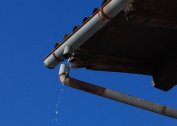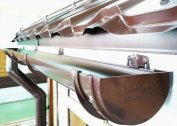For the first time faced with the purchase of pipes for sewage, an inexperienced person, having come to the building materials store, is confused by the abundance of various options that modern manufacturers offer. It turns out that sewer pipes come in different colors, and this plays a key role in choosing the right name. The color of the pipe depends on its purpose. Moreover, it is not chosen arbitrarily, but strictly according to the standard: pipes with the same purpose from different manufacturers will be of the same color.
General approach to the selection of sewer pipes
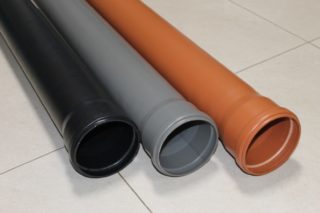 Pipes of different colors have various characteristics:
Pipes of different colors have various characteristics:
- strength;
- thermal conductivity;
- resistance to temperature extremes;
- corrosion resistance.
The color of the pipe must be selected depending on the conditions in which it will be used. Of course, you can save and choose on the principle that is cheaper. But such savings will result in additional costs for dismantling the system, and the house at that time will be without sewage.
What color, where and why is it used
Painting sewer pipes in appropriate colors, depending on the purpose, greatly simplifies the process of purchasing materials and laying communications.
Gray
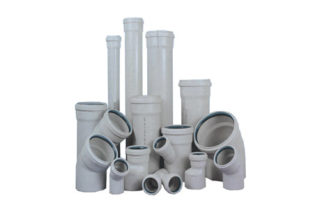 Gray pipes are designed for home installation. They are made of polypropylene and have the following characteristics:
Gray pipes are designed for home installation. They are made of polypropylene and have the following characteristics:
- Designed for effluents with temperatures up to 60-75 ° С, although they can withstand the temperature of 90 ° С for a short time;
- chemically inert: they are not subject to corrosion and do not emit harmful substances;
- low strength, wall thickness 2.7 mm, are deformed even with a force of 50-75 kgf / m2 (not suitable for underground installation);
- have a low cost.
Gray pipes are excellent for indoor use. They are laid with a slope in places where they will not be subjected to mechanical stress, the ambient temperature should not be lower than 0 ° C.
Redheads
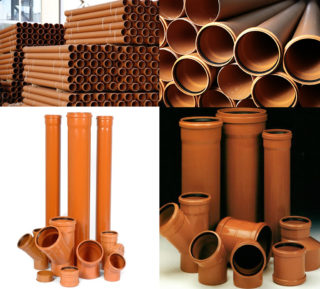 Pipes of orange color (“red”) are designed for laying the sewer network outside the house. The bright color for them was not chosen by chance: they are clearly visible, which reduces the risk of accidental damage during land work. The material of manufacture is polyvinyl chloride. They are more expensive than gray ones, but they have higher quality characteristics:
Pipes of orange color (“red”) are designed for laying the sewer network outside the house. The bright color for them was not chosen by chance: they are clearly visible, which reduces the risk of accidental damage during land work. The material of manufacture is polyvinyl chloride. They are more expensive than gray ones, but they have higher quality characteristics:
- Durable, divided into 3 classes of stiffness: light pipes (class L) - withstand up to 200 kgf / m2, laid at a depth of 2 m, not suitable for laying under the highway; medium-hard pipes (class N) - withstand loads up to 400 kgf / m2, laid at a depth of 6 m; rigid pipes (class S) - can withstand a load of up to 800 kgf / m2, laying depth - up to 8 m.
- They have low thermal conductivity due to the porous layer, so the depth of the laying does not depend on the thickness of freezing of the soil;
- Both high and low temperatures are equally well tolerated, these differences do not affect the properties of the pipes.
Red pipes can be smooth and corrugated. In the second case, they have a large surface area and, due to the redistribution of soil pressure, are more resistant to loads.
Polyvinyl chloride pipes have a significant drawback: they can be destroyed under the influence of aggressive effluents (acids, oils). In this case, it is better to use multilayer products from unplasticized polyvinyl chloride (NPVC), which is absolutely responsive to the effects of any aggressive environment.
When using red pipes for laying external communications, one can count on the fact that the real life of the sewage system will be close to the predicted one.
Black
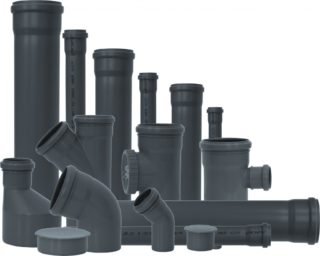 Black pipes are made of high pressure polyethylene and differ in the following features:
Black pipes are made of high pressure polyethylene and differ in the following features:
- increased strength and resistance to water hammer, which is achieved thanks to the corrugated walls on the outside and smooth inside, can be laid at great depths (up to 15 meters);
- lack of corrosion when interacting with aggressive substances;
- long service life - up to 50 years;
Black pipes basically make large diameters (250-850 mm, maybe larger), they are used for urban sewage systems when large volumes of wastewater are required to be passed. The maximum temperature of the passing liquid should not be more than 60 ° С.
Black pipes are often used as protection for cables that run deep.
There is a variety of black pipes that are used for drainage, they are easily recognizable by the presence of holes in the walls.
Whites
 White pipes are used for the internal sewer network. They have the same basic characteristics as gray ones, but have a more aesthetic appearance. White pipes are used when it is necessary to lay communications openly, so as not to spoil the interior of the room. For example, a white pipe is used in a toilet to divert drains from the toilet.
White pipes are used for the internal sewer network. They have the same basic characteristics as gray ones, but have a more aesthetic appearance. White pipes are used when it is necessary to lay communications openly, so as not to spoil the interior of the room. For example, a white pipe is used in a toilet to divert drains from the toilet.
A feature of white pipes is good sound absorption and low thermal conductivity. They withstand temperatures up to 95 ° C. Available in diameters from 32 mm to 150 mm, and the length of a single piece can be from 15 cm to 5 m. For ease of installation, manufacturers place a centimeter scale on the surface of white pipes, according to which it is easy to measure the required pipe length.
Green
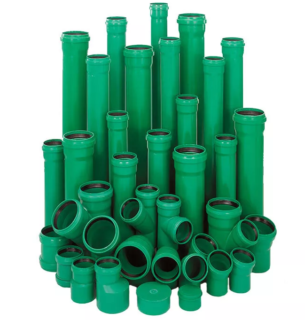 Green color (sometimes blue) have pipes that are used for drainage. They easily bend and well withstand the weight of sagging soil. They perfectly tolerate temperature fluctuations and its negative values. On the walls of green pipes there is usually a perforation for better drainage. Some manufacturers are improving their products by equipping them with a geotextile filter.
Green color (sometimes blue) have pipes that are used for drainage. They easily bend and well withstand the weight of sagging soil. They perfectly tolerate temperature fluctuations and its negative values. On the walls of green pipes there is usually a perforation for better drainage. Some manufacturers are improving their products by equipping them with a geotextile filter.
Saving on the quality of pipes for sewage is not worth it. Dismantling and replacement will cost more than initially reasonable investment in quality materials. If there are doubts about the conditions under which the pipes will be operated, it is better to play it safe and take more protected ones. In any case, you will win, since the life of the sewer will be longer.
